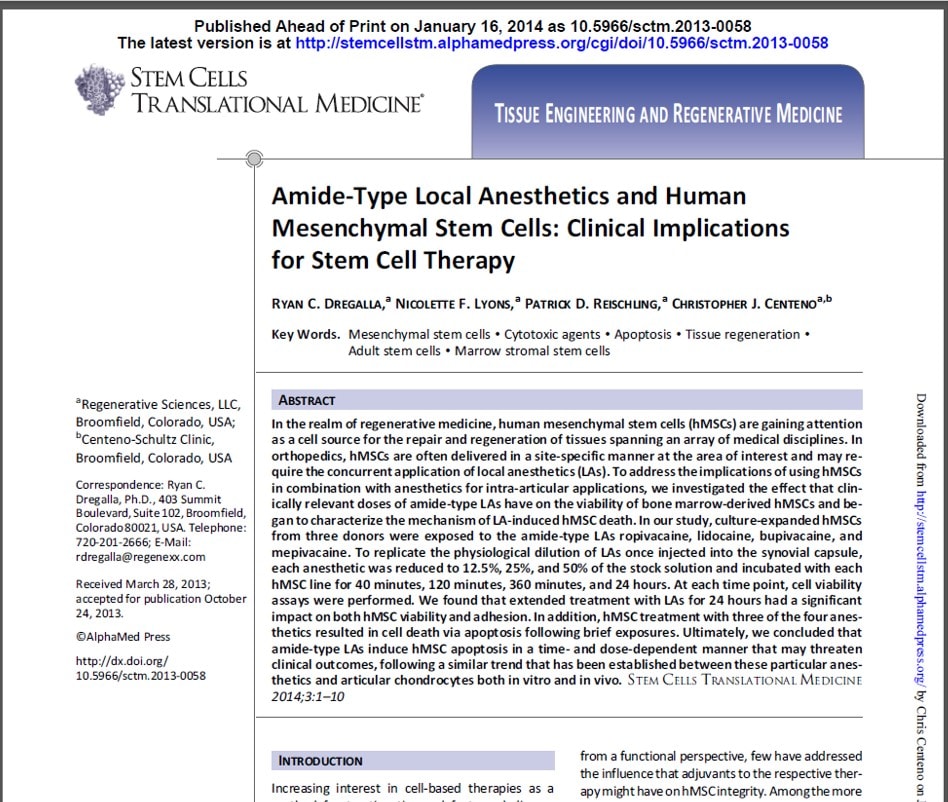New Regenexx Local Anesthetics Paper Published
Over the past year we’ve seen an explosion in clinics playing with stem cells, many only dabbling in the practice. Since 2005 we have published much of the world’s literature on the use of stem cells in orthopedic injuries. In 2007, we became concerned about the exposure of stem cells to local anesthetics as our lab tests showed that even low concentrations of these drugs killed mesenchymal stem cells quite dead. We got rid of the two main offenders-marcaine (bupivacaine) and lidocaine. It took a few years for the rest of the world to catch up, but over the past few years the American Academy of Orthopedic Surgery has issued a warning to it’s members not to use marcaine in joint injections, as it kills cartilage cells. Despite this warning, it’s amazingly still common practice to get marcaine injected into joints. In addition, many of these newer stem cell clinics routinely use these toxic anesthetics with cells. Last year a paper was published that seemed to suggest two of the three anesthetics being used were OK with stem cells. These were lidocaine and ropivacaine. The paper had a major flaw in that it only looked at whether cells were alive or dead and not injured or on their death beds. This is like evaluating a drug for a patient population and only counting if the patient is alive or dead after taking the drug and not asking if they’re horribly sick. So we knew that paper had to be redone.
Doing the paper right was a huge financial and resource commitment. This is because it involved advanced metrics like flow cytometry, fluorescent microscopy, and PCR. However, we also knew that this issue would continue to swirl around and hurt patients unless someone did the work and began to put the issue to bed. So we donated our private funds and time and did the research (i.e. this wasn’t a project paid for by Uncle Sam through grant money). The paper was just published yesterday in the Journal Stem Cells-Translational Medicine.
What did we find? The two anesthetics that we knew to be problems from our early research still showed that they hurt cells (marcaine and lidocaine). Marcaine is so toxic that even tiny amounts of it will decimate almost all of the stem cells in a sample. Lidocaine is less toxic, but at the amounts commonly used, it still beats up on and significantly injures the overall health of stem cells. Carbocaine (mepivacaine) is also a problem. The only anesthetic that can possibly be used around stem cells is ropivacaine, which regrettably isn’t usually found in orthopedic or pain management offices as it’s most common use is in labor and delivery. Even that anesthetic must be diluted to about 25% of normal strength to have minimal impact on cells (25% dilution by volume of 0.5%).
Why spend the time, money, and resources to do this study? Why put that information into the publicly available literature indexed in the US National Library of Medicine? It was the right thing to do not only to determine if there is any anesthetic in any quantity that could be used in our stem cell patients, but to continue to advance the science for all stem cell patients and physicians. Again, this is the Regenexx difference…

NOTE: This blog post provides general information to help the reader better understand regenerative medicine, musculoskeletal health, and related subjects. All content provided in this blog, website, or any linked materials, including text, graphics, images, patient profiles, outcomes, and information, are not intended and should not be considered or used as a substitute for medical advice, diagnosis, or treatment. Please always consult with a professional and certified healthcare provider to discuss if a treatment is right for you.

